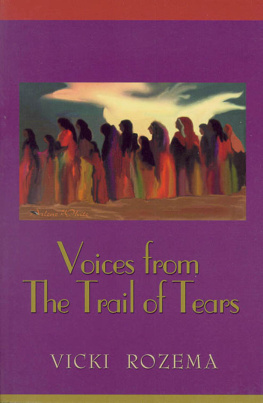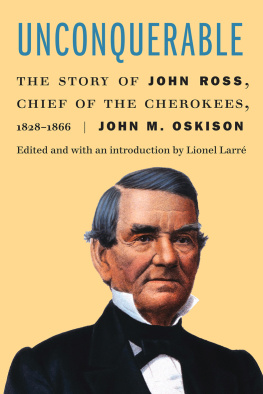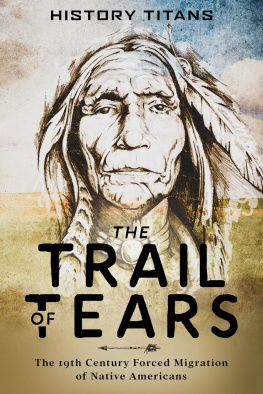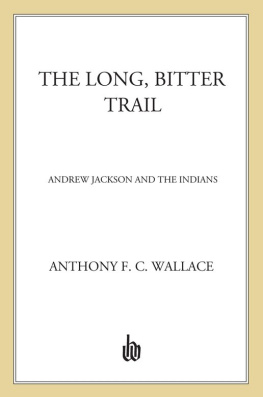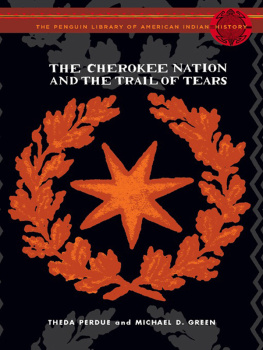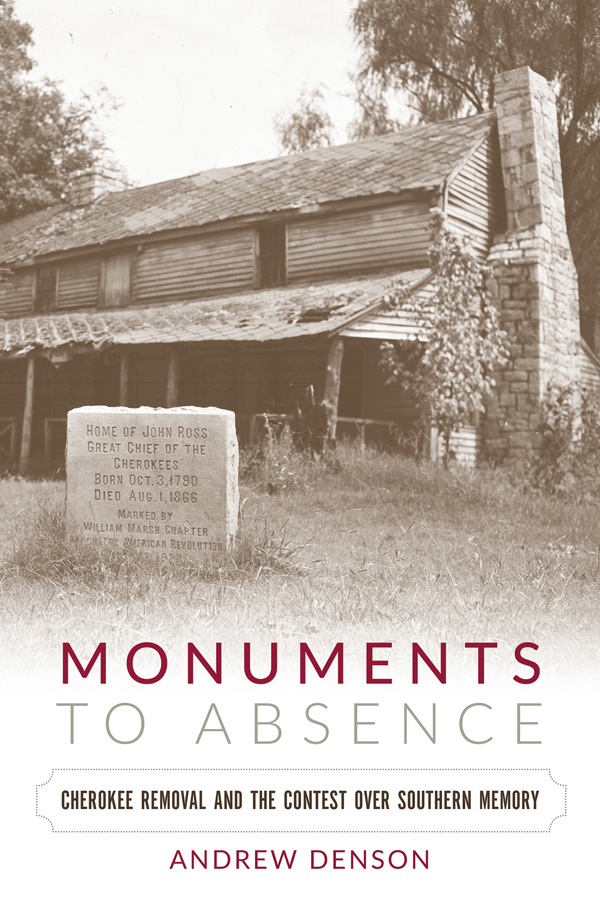Contents
Guide
Pagebreaks of the print version
Monuments to Absence
Monuments to Absence
Cherokee Removal and the Contest over Southern Memory

ANDREW DENSON
The University of North Carolina Press Chapel Hill
This book was published with the assistance of the Fred W. Morrison Fund of the University of North Carolina Press .
2017 The University of North Carolina Press
All rights reserved
Set in Charis and Lato by Westchester Publishing Services
Manufactured in the United States of America
The University of North Carolina Press has been a member of the Green Press Initiative since 2003.
Library of Congress Cataloging-in-Publication Data
Names: Denson, Andrew.
Title: Monuments to absence: Cherokee removal and the contest over southern memory / Andrew Denson.
Description: Chapel Hill: University of North Carolina Press, [2017] | Includes bibliographical references and index.
Identifiers: LCCN 2016021186| ISBN 9781469630823 (cloth: alk. paper) | ISBN 9781469630830 (pbk: alk. paper) | ISBN 9781469630847 (ebook)
Subjects: LCSH : Trail of Tears, 18381839Public opinion. | Cherokee IndiansRelocationPublic opinion. | Collective memorySouthern States.
Classification: LCC E 99. C 5 D 47 2017 | DDC 975.004/97557dc23 LC record available at https://lccn.loc.gov/2016021186
Cover illustration: Home of Cherokee leader John Ross, with DAR Memorial, Rossville, Georgia, circa 1940. Courtesy Chattanooga Public Library, Paul A. Heiner Collection.
Portions of this book were previously published in a different form. The Introduction and Epilogue include material from Reframing the Indian Dead: Removal Era Cherokee Graves and the Changing Landscape of Southern Memory, in Death and the American South , ed. Craig Thompson Friend and Lorri Glover (New York: Cambridge University Press, 2015), 25074. Chapters 1 and 2 include material from Gatlinburgs Cherokee Monument: Public Memory in the Shadow of a National Park, Appalachian Journal 37 (FallWinter 2009), Appalachian Journal and Appalachian State University. Chapter 4 includes material from Remembering Removal in Civil RightsEra Georgia, in Southern Cultures 14, no. 4 (Winter 2008). Chapters 4 and 5 include material from Native Americans in Cold War Public Diplomacy: Indian Politics, American History, and the U.S. Information Agency, American Indian Culture and Research Journal 36, no. 2 (2012), Regents of the University of California. All material used here with permission.
For Kelly Larson
Contents
Illustrations
,
,
,
,
,
,
,
,
,
,
,
,
,
,
Acknowledgments
A great many people helped me as I researched and wrote this book. I am very lucky to work at Western Carolina University with fine historians and good people like Gael Graham, Jessie Swigger, Elizabeth McRae, Richard Starnes, Mary Ella Engel, and Jim Lewis, all of whom have helped me in myriad ways. I am also grateful to my colleagues in the Cherokee Studies Program at WesternTom Belt, Roseanna Belt, Tom Hatley, Brett Riggs, Jane Eastman, Hartwell Francis, and Anne Rogers, all of whom know more about these Cherokee mountains than I suspect I ever will. Thanks also to the universitys scholarly reassignment program, which allowed me to complete the research.
Tiya Miles, Claudio Saunt, Jace Weaver, Malinda Maynor Lowery, Craig Friend, and Theda Perdue provided sound advice and useful comments at various stages of the project. I am indebted, as well, to my fellow heritage workers in the Trail of Tears Association, who shared their insights on contemporary commemoration of Indian removal: Jack Baker, Jeff Bishop, Shirley Lawrence, Susan Abram, Bobbie Heffington, Michael Abram, Sarah Hill, Alice Murphree, and Patsy Edgar. Mark Simpson-Vos at the University of North Carolina Press supported the project from the start and provided both sound advice and the right mix of patience and prodding. I am grateful to the anonymous reviewers for their rigorous, critical readings of the manuscript. The book is much better for their careful analyses.
Public historians in several places provided invaluable assistance. T. J. Holland with the Eastern Band of Cherokee Indians, David Gomez at the New Echota State Historic Site, Duane King of the Gilcrease Museum, George Frizzell at Western Carolina University, Tom Mooney and Jerry Catcher Thompson at the Cherokee Heritage Center, and the librarians and staff of the local history collections at the Chattanooga Public Library all have my lasting gratitude. I could not have written the final chapter without the work of Daniel Littlefield and the wonderful Sequoyah National Research Center at the University of Arkansas, Little Rock.
Suzette Raney, Ethan Clapsaddle, Jerry Catcher Thompson, and Sharon Sanders helped me find illustrations. I am especially grateful to artist Jeff Marley, who let me use an image from his excellent We Are Still Here project.
I dont know how well John Bodnar remembers me from my graduate school years, but it was during his seminar on public history at Indiana University in the 1990s that I first started thinking about history and memory. That experience has shaped much of my subsequent career.
Finally, my greatest debt is to Kelly Larson, who has lived with this project and my weird obsession with community pageants, roadside markers, and obscure historical monuments for longer than I had a right to ask. I am glad she was there from the start.
Monuments to Absence
Introduction
This book began with tourism. In the summer of 1994, a friend and I drove from Bloomington, Indiana, where I attended graduate school, to Florida for a short vacation. As we sped along Interstate 75 through northern Georgia, I spotted a brown roadside sign announcing that, at the next exit, we would find New Echota, a state historic site interpreting the history of the Cherokee Nation. For a brief time in the early nineteenth century, New Echota was the Cherokee capital, the seat of the national government created by tribal leaders in the 1820s. The Cherokee National Council met at New Echota in the years prior to removal, and it was the site of the Cherokee Supreme Court. During a time when the United States and the state of Georgia pressured Cherokees to emigrate to the West, the new capital represented the Cherokees determination to remain in their homeland. It was also the place where, in late 1835, a small group of tribal leaders signed the treaty under which the United States forced the Cherokee Nation to remove. I had recently become interested in the history of Cherokee sovereignty and nationhood, and I concluded that I should probably know about this heritage attraction. We pulled off the highway and followed the signs to the site.
New Echota turned out to be an elaborate reconstruction of the antebellum Cherokee town, spread across a wide meadow near the Coosawatee River. Touring the site, we visited buildings representing the Cherokee Council House and Supreme Court, as well as a model Cherokee farmstead. New Echota included a reconstruction of the office of the Nations bilingual newspaper, the Cherokee Phoenix , complete with a period printing press. It also contained two original structures, a tavern that once belonged to the Cherokee Vann family and the home of Samuel Worcester, a missionary who operated out of New Echota and helped to establish the Phoenix . Finally, there was a small museum where exhibits explained the history of the site and recounted the story of Cherokee removal.


